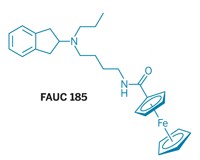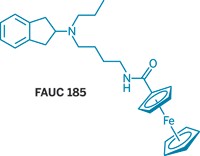Advertisement
Grab your lab coat. Let's get started
Welcome!
Welcome!
Create an account below to get 6 C&EN articles per month, receive newsletters and more - all free.
It seems this is your first time logging in online. Please enter the following information to continue.
As an ACS member you automatically get access to this site. All we need is few more details to create your reading experience.
Not you? Sign in with a different account.
Not you? Sign in with a different account.
ERROR 1
ERROR 1
ERROR 2
ERROR 2
ERROR 2
ERROR 2
ERROR 2
Password and Confirm password must match.
If you have an ACS member number, please enter it here so we can link this account to your membership. (optional)
ERROR 2
ACS values your privacy. By submitting your information, you are gaining access to C&EN and subscribing to our weekly newsletter. We use the information you provide to make your reading experience better, and we will never sell your data to third party members.
Biological Chemistry
Neuron Activation
Scientists crack how a family of brain cell receptors receives and responds to chemical signals
by Sarah Everts
October 2, 2006
| A version of this story appeared in
Volume 84, Issue 40

Switching elegantly between electrical and chemical signals, the neurons in our brain help us react to new challenges, figure out how to improve our responses, and remember how to do it again.
Almost all brain activity consists of an electrical pulse that travels along the length of a neuron and stimulates the massive release of chemical neurotransmitters into the synapse, the space between neurons. These chemicals sprint across the synapse, triggering an electrical pulse in nearby neurons.
Yet the mechanism by which chemical signals from one neuron elicit an electrical response in another has long challenged brain researchers. They've identified the chemical neurotransmitters and the protein receptors to which they bind. They've figured out that this binding event leads to a conformational change in the protein receptor that opens up an ion channel to a flux of charged atoms, igniting the electrical signal. But exactly how these conformational changes occur, especially when some neurotransmitters bind tens of angstroms away from the ion channel they open, has kept brain scientists scratching their heads.
Using chemical tools, Dennis A. Dougherty and his collaborators from the California Institute of Technology are teasing apart the way neurotransmitters bind and trigger channel openings. He presented his findings at the American Chemical Society meeting in San Francisco, in a symposium organized by the Division of Biological Chemistry.
Dougherty plunged into the world of neuroscience through an avid interest in a unique form of noncovalent binding. A physical organic chemist by training, Dougherty had spent the 1980s studying the cation-π interaction, in which the electron-rich surface of an aromatic ring interacts favorably with a cation. Dougherty's group later showed that this cation-π interaction is key to how the common neurotransmitter acetylcholine binds its receptor.
Acetylcholine's membrane-protein receptor is a member of the ubiquitous Cys-loop superfamily of neurotransmitter receptors. Its relatives include those proteins responsible for sensing neurotransmitters such as serotonin, as well as the neurotransmitter receptors targeted by sedatives and antianxiety benzodiazepine drugs like Valium.
"The good news is that Cys-loop receptors are incredibly important molecules: They are involved in memory and sensory perception," said Dougherty. "The bad news is they are large, complex membrane proteins."
As a self-described small-molecule physical organic chemist, Dougherty decided that if he wanted to do chemistry on large unwieldy neurotransmitter receptors, he should establish a collaboration with a brain biologist. Caltech neurobiologist Henry A. Lester was "just 25 feet away, on the same floor," so in the early 1990s, he took a two-minute walk to Lester's university office and proposed a partnership.
"It's been a very successful collaboration," Lester told C&EN. "Putting our minds together, we've been able to hit pay-dirt numerous times."
Collectively, they have been able to surmount two major challenges in studying the mechanism of Cys-loop receptors. The first is that it is impossible to reconstitute a functioning neuroreceptor by itself in a test tube. In addition to needing a membrane with an electrical potential across it to function, the proteins require a lot of biological processing. Neurobiologists solve the problem by inducing a frog's egg, an oocyte, to build the receptors because it has the right biological machinery and a membrane devoid of interfering proteins.
The function of a neuroreceptor in these oocytes can be studied by using a technique called electrophysiology. This technique allows researchers to measure the current produced when a single protein channel opens. This method is also powerful because researchers can ensure the protein is functional, not just folded.
The second challenge to studying Cys-loop receptors is that no crystal structure has been solved, even though researchers have been trying for decades. The best are rough grain structures based on electron microscopy and structures of similar proteins which researchers mine for ideas. "Younger students who have grown up with so many crystallized proteins are shocked that we can work without the structure," Dougherty said. "We are using chemistry to get valuable information without it." He points out that the crystal structure doesn't give functional insight, as the tools of electrophysiology do. To boot, electrophysiology is sensitive to single ion-channel proteins.

What researchers do know about the Cys-loop receptor structure is that it is composed of five similar protein subunits that create a circular pore. The pore is blocked by five leucine side chains, which are pulled out of the way by the conformational change that occurs when neurotransmitters bind.
Neurotransmitters bind to members of the Cys-loop receptor family at a site consisting of five aromatic amino acids. Careful chemical changes to this so-called aromatic box allowed Dougherty to prove that the cation-pi interaction was essential for a neurotransmitter to bind to its receptor.
To do so, his team built a portfolio of modified tryptophans by incrementally substituting hydrogens on the tryptophan's aromatic ring with fluorines. "Substitution at any of the hydrogen sites by a fluorine knocks down a cation-π interaction," Dougherty said. "So we thought that incorporating the modified tryptophans into the neurotransmitter receptor would lower binding efficiency if cation-π interactions were important for binding." Lo and behold, such substitutions caused a defined drop in binding efficiency.
These experimental successes are the benefit of collaborating with a chemist, Lester said. "Using chemistry, it is possible to make subtle and graded changes in the characteristics of a protein side chain, and using electrophysiology, we are able to make precise measurements of the functional consequences of these changes."
The pair repeated these experiments for many of the members of the Cys-loop receptors and showed that a cation-π interaction was indeed the important interaction that leads to receptor binding. But this is where the tough part of neurochemistry comes into play. Although binding always occurs through a cation-π interaction, serotonin binds to a different tryptophan in its aromatic box than does acetylcholine. Benzodiazepine receptors rely on yet another aromatic residue in the box to bind the drug.
"These receptors are all sort of mushy," Dougherty remarked. "The difference between receptor biology and enzyme biology is that in an enzyme active site there's a molecule inside with all these perfect hydrogen-bonds, locking it in, with perfect stereochemistry, because that's what enzymes do for a living," Dougherty added. "Receptors do not mediate a stereospecific transformation on a small molecule. Receptors switch between states, open and closed, active and inactive. They send signals. All a drug has to do is to get there and throw the switch." This is why nicotine, a molecule that looks only slightly like acetylcholine, can bind and activate the acetylcholine receptor and does so regularly in the brains of smokers, he explained.
After figuring out how these receptors bind their neurotransmitters, Dougherty and colleagues set out to understand how binding induces a conformational change that opens a channel some 60 Å away from the binding site. They found that cis-trans isomerization of a proline is the switch that converts the channel between open and closed states (Nature 2005, 438, 248).
"When you see a proline, you get suspicious about things, including cis-trans isomerization," Dougherty said. "And that's where a biologist stops. They mutate the proline to alanine, which kills the receptor, and then they say, 'Well, okay, I knew that the proline was important, but what is it important for?' That's where the power of chemistry comes in."
The proline that caught Dougherty's eye sits right on the boundary between the ion-channel domain and the neurotransmitter-binding domain. He and his colleagues synthesized several proline analogs and inserted them into the receptor at this boundary site. Then, using electrophysiology they checked whether the mutant receptors could still open their ion channel to allow ion currents to flow.
The researchers found that mutants that strongly favored the trans conformation never successfully opened the channel, whereas some of those that strongly favored the cis conformation were irreversibly opened. Mutants containing proline analogs with intermediate preferences for cis and trans had a range of opening and closing values.
To explain their findings, Dougherty, Lester, and Sarah Lummis of Cambridge University, in England, proposed that in the closed state, the proline is in the trans conformation, but binding of neurotransmitter induces a conformational change that allows the proline to isomerize into the cis conformation. This proline isomerization reorients an a-helix that opens the channel.
This same proline is responsible for opening the serotonin receptor, Dougherty reported. But other Cys-loop receptors that have exactly the same proline are not opened via this particular switch. Perhaps, Dougherty pointed out, this is because cis-trans isomerization would be useful for a switch needing a millisecond response time, such as the serotonin receptor in the brain, but it would not be as useful in muscle switches, which require a microsecond response time.
"At first glance, you might think that if we solve the problem for one neuroreceptor, we've solved it for the whole family," Dougherty said. "But if there's a recurring theme in neuroscience, it's that it is really complicated. Nature chose a universal structural platform for these neuroreceptors but not a uniform mechanism of action. But we can use chemistry to probe mechanism of action, and we will continue to do so."





Join the conversation
Contact the reporter
Submit a Letter to the Editor for publication
Engage with us on Twitter